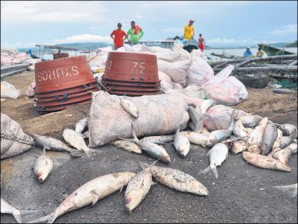Weather change led to Batangas fishkill, says BFAR

FISHKILL Workers bring to port tons of milkfish (“bangus”) killed in the Taal Lake in Batangas following a drop in temperature. ARNOLD ALMACEN
BATANGAS CITY—A sudden drop in temperature that lowered oxygen level at the onset of the rainy season in Taal Lake has killed 752.6 metric tons of fish worth P57.226 million since Friday, officials said on Sunday.
The fishkill was the worst climate change disaster to hit Batangas, according to Rosario del Mundo of the Bureau of Fisheries and Aquatic Resources (BFAR) office in the province.
The loss at Talisay town’s side of the lake involved 375 MT of bangus (milkfish); 160 MT of tilapia, 50 MT of bangus and 1.6 MT of bangus fingerlings in Laurel town; 160 MT tilapia in Agoncillo; and 12 MT of bangus in San Nicolas.
Del Mundo said she first received the report of a decrease in oxygen level at the lake on Thursday, and the cultured fish began dying by the next day.
“If the dissolved oxygen drops and it rains, the fish cannot breathe and it dies,” she said.
Article continues after this advertisementSchools of fish were seen swimming in circles before they floated dead to the surface in huge numbers. The deaths have occurred in the past at summer’s end, but in much smaller numbers, officials said.
Article continues after this advertisementBiya, a fish species that only thrives in the lake, and crabs also died.
Del Mundo said the loss could still go higher because some fish cage owners, mostly Chinese, were still determining damage.
Talisay Mayor Zenaida Mendoza yesterday said she had ordered the dead milkfish, unfit for eating, buried under a mixture of soil and lime to dispel the foul odor in an isolated and upland area of Barangay Sampaloc.
Mendoza said that Gov. Vilma Santos-Recto sent a backhoe to help in the disposal, hampered by heavy rains.
Aquaculture is a multimillion-peso enterprise in Batangas, with at least 6,000 fish cages dotting the Taal Lake. With a report from AP